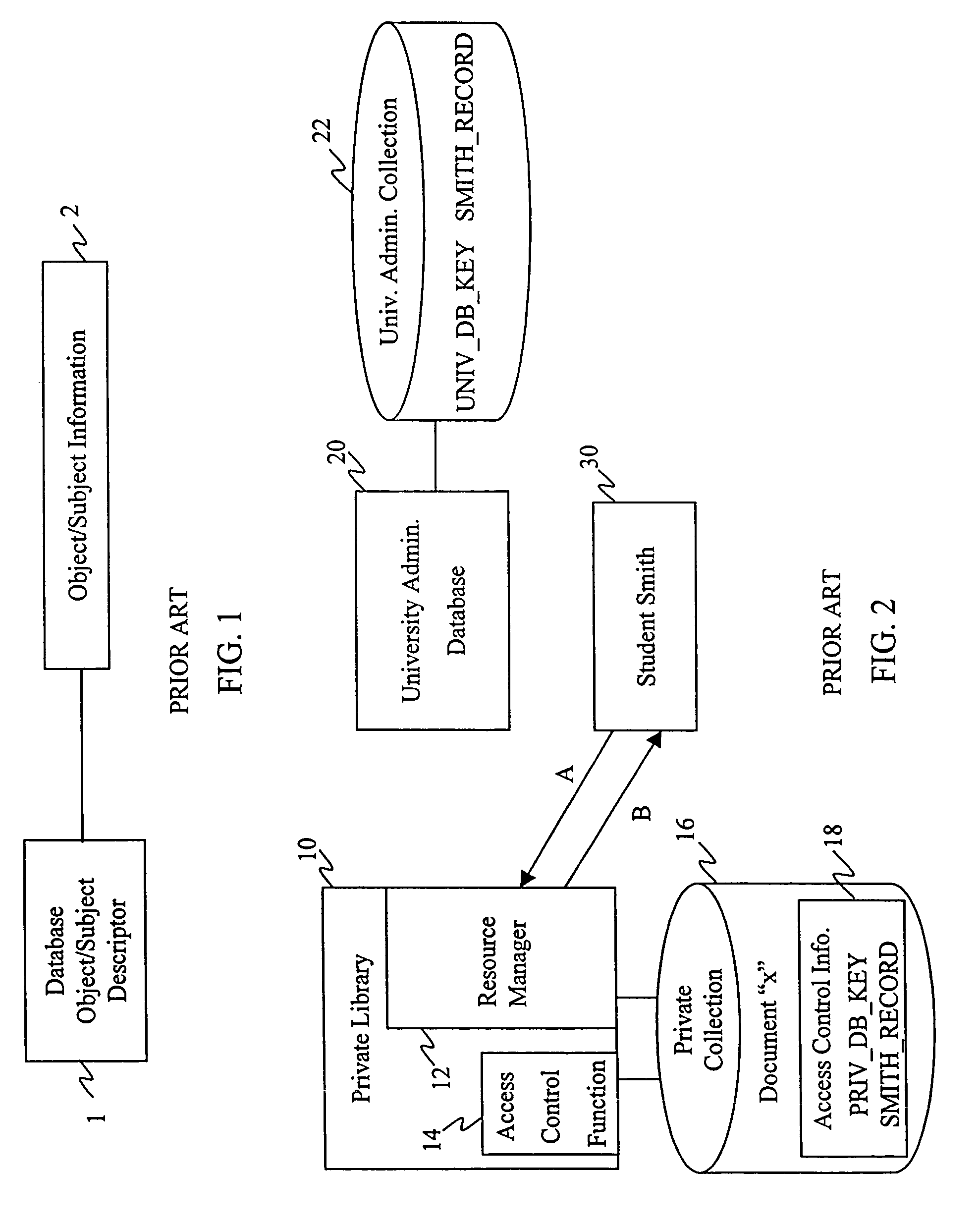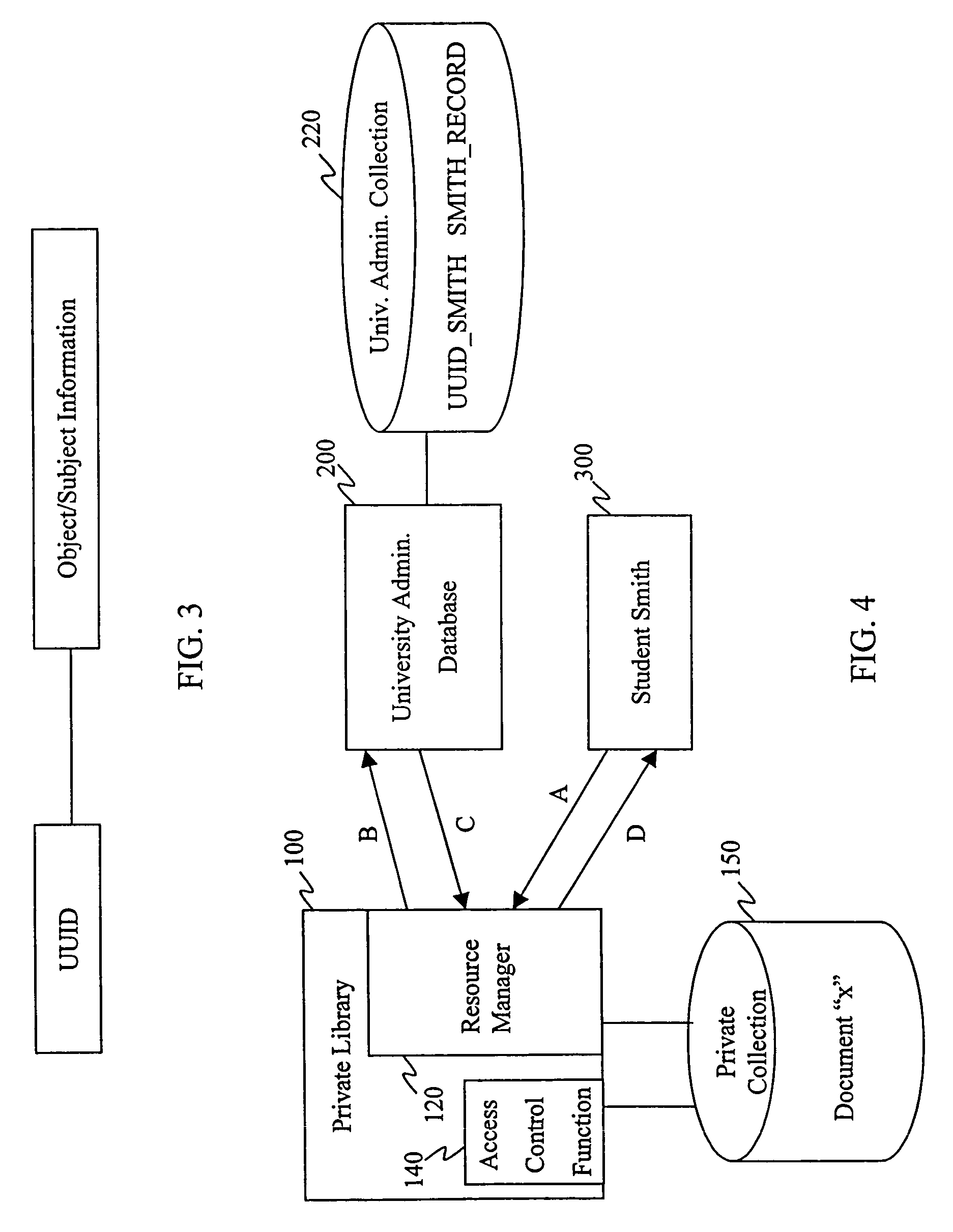Distributed data structures for authorization and access control for computing resources
a computing resource and data structure technology, applied in the field of information storage and processing, can solve the problems of imposing on the computing system outside the university the cost and tolerated cost of computing system, reducing the significant administrative cost, and reducing the administrative burden
- Summary
- Abstract
- Description
- Claims
- Application Information
AI Technical Summary
Benefits of technology
Problems solved by technology
Method used
Image
Examples
first embodiment
A FIRST EMBODIMENT
[0034]FIG. 4 shows an access control system employing a first embodiment of the invention in the context of the university / private library example discussed above. In this example an access control function 110 operates as part of the private library 100 and in conjunction with access control information (not shown), and comprises an access control reference monitor. The private library includes a private collection 120, which holds a document “x”.
[0035]External to the private library's administrative domain is the university's computing systems. The university's computing systems include an administrative database 200 managing an administrative collection 220 holding administrative records about university faculty, staff and students 200.
[0036]The records stored within the administrative collection 200 are stored according to the invention. That is, each record is stored bound to a UUID as a descriptor of that record. In this example the administrative record for ...
second embodiment
A SECOND EMBODIMENT
[0045]FIG. 5 shows a second embodiment of an access control system using the invention. Here, instead of the access control function 110 resolving the UUID, the user computing system 300 gathers from the university's administrative database the subject information required by the access control function 110. In this case the user, Smith, knows of information needed by the private library's access control function and gathers it by sending a request “A” to the university administrative database 200 with the UUID for the subject information. The database retrieves the information in the same manner as in the first embodiment, but returns it, via response “B”, to the user's computing system 300. The user's computing system 300 then sends to the private library's access control function 110 in request “C” the information retrieved from the university's database. The access control function is performed in the same manner as previously described and a yes / no response “...
third embodiment
A THIRD EMBODIMENT
[0046]In a third embodiment subject information, organization information and object information are bound to UUIDs, which permit even greater distribution of such information. FIGS. 6A-C show an example of these types of information in the context of user descriptions, organization graphs and object information. FIG. 7 shows an access control system according to the third embodiment.
[0047]Here, the university administrative database 200 includes in the administrative collection 220 organization information bound to organization UUIDs, as depicted in FIG. 6B. The organization information specifies as a graph, members of the organization. For example, organization A (ORG_A) is comprised of subjects “1” through “L” and organization B (ORG_B) is comprised of subjects “L” through “M”. Each of the organization information is bound to an organization UUID (e.g., UUID ORG_A). The organization information can be viewed as an organization graph as shown in FIG. 6D.
[0048]In ...
PUM
 Login to View More
Login to View More Abstract
Description
Claims
Application Information
 Login to View More
Login to View More - R&D
- Intellectual Property
- Life Sciences
- Materials
- Tech Scout
- Unparalleled Data Quality
- Higher Quality Content
- 60% Fewer Hallucinations
Browse by: Latest US Patents, China's latest patents, Technical Efficacy Thesaurus, Application Domain, Technology Topic, Popular Technical Reports.
© 2025 PatSnap. All rights reserved.Legal|Privacy policy|Modern Slavery Act Transparency Statement|Sitemap|About US| Contact US: help@patsnap.com



